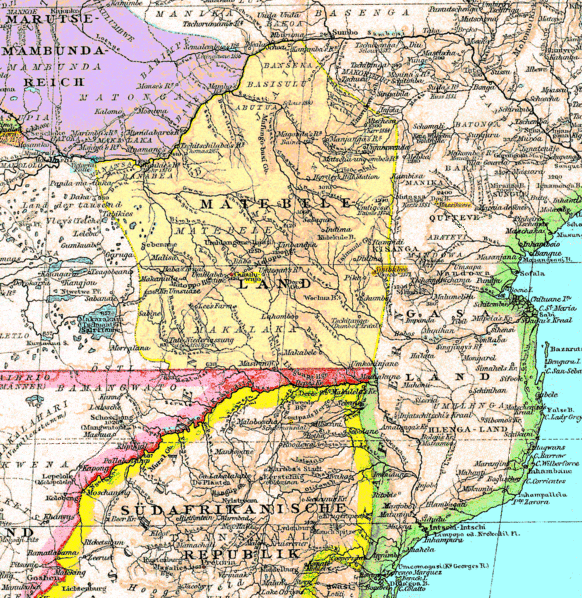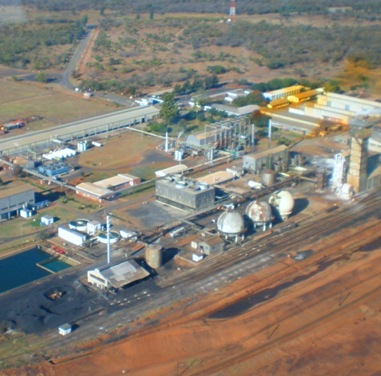|
Amaveni
Amaveni Township is a high density suburb in Kwekwe, Zimbabwe. It is about west of the city's central business district. The township's name of 'Amaveni' according to one of its first residents, the late Jonas Macela Nkomo (1908–2002), was derived from a Ndebele army's battalion that was called by the same name. The battalion fought during the 1893 Anglo-Ndebele war in Matebeleland region of Zimbabwe. History Amaveni is one of the oldest suburbs or townships in Zimbabwe. It was established at the beginning of the 20th century by the Southern Rhodesian colonial authorities as a racially segregated dormitory township for African male labourers. Most of these labourers worked as house servants for white families in the nearby suburbs of Fitchlea, Newtown, Masasa Park and Hillandale or in the newly established shops and factories. Some of the residents also worked for the nearby gold mines of Globe and Phoenix, Gaika and Riverlea, particularly those who could not be housed at the ... [...More Info...] [...Related Items...] OR: [Wikipedia] [Google] [Baidu] |
Kwekwe
Kwekwe ( ), known until 1983 as Que Que, is a city in the Midlands province of central Zimbabwe. The city has a population of 119,863 within the city limits, as of the 2022 census, making it the 7th-largest city in Zimbabwe and the second-most populous city in the Midlands, behind Gweru. Location It is located in Kwekwe District, in the Midlands, in the center of the country, roughly equidistant from Harare to the northeast and Bulawayo to the southwest. It has witnessed robust population growth since the 1980s, growing from 47,607 in 1982, 75,425 in 1992 and the preliminary result of the 2002 census suggests a population of 88,000. In 2012, the city's population was estimated at 100,900 people. It is a centre for steel and fertiliser production in the country. Kwekwe and neighbouring Redcliff are the headquarters of Zimbabwe Iron and Steel Company (ZISCO), the country's largest steelworks. It also hosts the Zimbabwe Iron and Smelting Company (ZIMASCO), the largest ferrochrom ... [...More Info...] [...Related Items...] OR: [Wikipedia] [Google] [Baidu] |
Zimbabwe
Zimbabwe (), officially the Republic of Zimbabwe, is a landlocked country located in Southeast Africa, between the Zambezi and Limpopo Rivers, bordered by South Africa to the south, Botswana to the south-west, Zambia to the north, and Mozambique to the east. The capital and largest city is Harare. The second largest city is Bulawayo. A country of roughly 15 million people, Zimbabwe has 16 official languages, with English, Shona language, Shona, and Northern Ndebele language, Ndebele the most common. Beginning in the 9th century, during its late Iron Age, the Bantu peoples, Bantu people (who would become the ethnic Shona people, Shona) built the city-state of Great Zimbabwe which became one of the major African trade centres by the 11th century, controlling the gold, ivory and copper trades with the Swahili coast, which were connected to Arab and Indian states. By the mid 15th century, the city-state had been abandoned. From there, the Kingdom of Zimbabwe was established, fol ... [...More Info...] [...Related Items...] OR: [Wikipedia] [Google] [Baidu] |
Matebeleland
Matabeleland is a region located in southwestern Zimbabwe that is divided into three provinces: Matabeleland North, Bulawayo, and Matabeleland South. These provinces are in the west and south-west of Zimbabwe, between the Limpopo and Zambezi rivers and are further separated from Midlands by the Shangani River in central Zimbabwe. The region is named after its inhabitants, the Ndebele people who were called "Amatabele"(people with long spears - Mzilikazi 's group of people who were escaping the Mfecani wars). Other ethnic groups who inhabit parts of Matabeleland include the Tonga, Bakalanga, Venda, Nambya, Khoisan, Xhosa, Sotho, Tswana, and Tsonga. The population of Matabeleland is just over 20% of the Zimbabwe's total. The capital and largest city is Bulawayo, other notable towns are Plumtree, Victoria Falls, Beitbridge, Lupane, Esigodini, Hwange and Gwanda. The land is fertile but semi arid. This area has coal and gold deposits. Industries include gold and other mineral ... [...More Info...] [...Related Items...] OR: [Wikipedia] [Google] [Baidu] |
Southern Rhodesia
Southern Rhodesia was a landlocked self-governing British Crown colony in southern Africa, established in 1923 and consisting of British South Africa Company (BSAC) territories lying south of the Zambezi River. The region was informally known as south Zambesia until annexed by Britain at the behest of Cecil Rhodes's British South Africa Company, for whom the colony was named. The bounding territories were Bechuanaland (Botswana), Northern Rhodesia (Zambia), Moçambique (Mozambique), and the Transvaal Republic (for two brief periods instead the British Transvaal Colony, from 1910 the Union of South Africa, and then from 1961 the Republic of South Africa). This southern region, known for its extensive gold reserves, was first purchased by the BSAC's Pioneer Column on the strength of a Mineral Concession extracted from its Matabele overlord, Lobengula, and various majority Mashona vassal chiefs in 1890. Though parts of the territory were laid claim to by the Bechuana and Po ... [...More Info...] [...Related Items...] OR: [Wikipedia] [Google] [Baidu] |
Zimbabwe Iron And Steel Company
Zimbabwe Iron and Steel Company is the largest steel works in Zimbabwe. It is located just outside Kwekwe, in Redcliff, Kwekwe District. Over the years the company has faced many operational problems and corruption scandals. History In 1942, the colonial government founded the Rhodesian Iron and Steel Commission (Riscom). It was sited at the steel plant at Redcliff, to develop the huge iron and limestone deposits nearby. In 1957, it changed its name to the Rhodesian Iron and Steel Company (Risco). It suffered from a lack of experienced personnel and low level of production which meant high unit costs. In 1954, a debt of 1.7 million pounds sterling had to been written off as irrecoverable. In 1956, the loss-making situation was turned into a profit-making situation due to the formation of the Federation of Rhodesia and Nyasaland and the denationalisation of the industry. In 1956, iron ore output from the company was 127,954 tons. By 1957, this had doubled to 257,166 tons.Leonard To ... [...More Info...] [...Related Items...] OR: [Wikipedia] [Google] [Baidu] |
Lancashire Steel Corporation
The Lancashire Steel Corporation Ltd was a United Kingdom steel producer. The company was formed in 1930 by amalgamating the iron and steel interests of the Pearson & Knowles Coal & Iron Co, the Partington Steel & Iron Co, and the Wigan Coal & Iron Co. The company was nationalised in 1951, becoming part of the Iron and Steel Corporation of Great Britain, but de-nationalised shortly afterwards. It was renationalised in 1967, becoming part of the British Steel Corporation. The main works were at Irlam Irlam is a suburb in the City of Salford, Greater Manchester, England. In 2011, it had a population of 19,933. It lies on flat ground on the south side of the M62 motorway and the north bank of the Manchester Ship Canal, southwest of Salford .... Sources * Whitaker's Almanack (various dates) Defunct companies of the United Kingdom Steel companies of the United Kingdom Former nationalised industries of the United Kingdom 1930 establishments in England History of Salfor ... [...More Info...] [...Related Items...] OR: [Wikipedia] [Google] [Baidu] |
Sable Chemicals
Sable Chemical Industries Limited is the sole manufacturer of ammonium nitrate (NH4NO3) in Zimbabwe. History Located in Kwekwe, Sable Chemical Industries Limited is Zimbabwe's sole manufacturer of nitrogen-based fertilizer, ammonium nitrate (AN). The company was incorporated in 1965 and started operations in 1969 using ammonia, a key raw material in the fertilizer making process, which at that time was imported through Sasol, South Africa. In 1972, Sable commissioned its own ammonia production facility via electrolysis of water. This saw the import quota reduce to 30% of total raw materials required to make AN. The nameplate capacity of the plant is per annum of AN. Air separation An air separation process is used to separate nitrogen from air for downstream use in the ammonia making process. By-products in the form of gaseous and liquid oxygen as well as small quantities of liquid nitrogen are formed. Five basic unit operations make up the air separation process: air compressio ... [...More Info...] [...Related Items...] OR: [Wikipedia] [Google] [Baidu] |
Blessing Chebundo
Blessing Chebundo (born 8 October 1958) is a Zimbabwean politician, a member of parliament and a leading figure in the opposition Movement for Democratic Change (MDC).Profile at MDC website . He rose to fame by defeating in a contest to represent constituency in the parliament of Zimbabwe in the 2000 parliamentary election.Lebo Nkatazo, "After 2 defeats, Mnangagwa opts for rural constituency"(Retrieved 11 ... [...More Info...] [...Related Items...] OR: [Wikipedia] [Google] [Baidu] |


